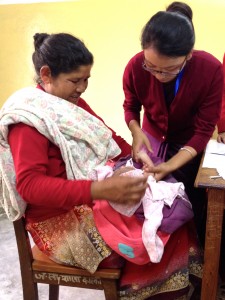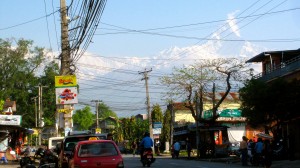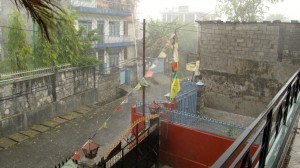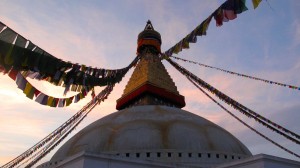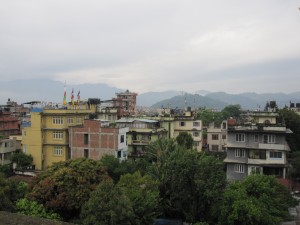I want to take a moment to write at least a little about our experience of the Nepal Earthquake of 2015/2072. Thousands of people have died and many more have been injured. People have lost homes. Whole villages are flattened. And even now almost two weeks later, aftershocks continue causing for many a rise in pulse and fear, as well as being a constant reminder of what has happened. Many people are still unable to live in their homes; instead, they sleep outside, under tarps if they have them, and weather the monsoon rains which have started a month early this year.
Our experience does not compare with those communities that bore the brunt of the earthquake’s magnitude, but before I can move on to share stories of birth and midwifery and learning, I feel a need and desire to tell our story (from my perspective; Jac and Emma – you can write from yours too!)
We had just arrived in Baglung and were in the midst of bartering for a better price in our hotel room with the manager when it happened. The walls started shaking and the floor started rolling under my feet which I have never experienced before. We ran out of the hotel as the manager yelled “Earthquake!” – and he fell really hard on the stone stairs as we came down from the 2nd floor. Everyone was running to the street and we followed suit. The streets in Baglung in our neighbourhood were only one lane wide (ie. very narrow!) and most of the buildings lining the streets were one, two or three storied old brick or concrete buildings, some topped with tin roofs held down with large rocks. There was also one huge glass building that no one wanted to be close to! Small groups of people huddled together, some standing in the middle of the dirt street, others crowding under tin overhangs. Cathy, Jacquie and I remained in the street and Emma ran for cover under the frame of a concrete building that was under construction. I know what she was thinking. As a child I was taught that the safest place – other than a wide, open space – is to stand in a door frame: everything will fall around it, but it is likely to remain upright and you safe under it. But – there was a huge piece of concrete overhang that seemed precarious from our vantage point, so we called her back over to us after a few moments.
It was actually pretty quiet in the streets. Some people were calling out to one another, but the stillness in the midst of such force was startling to me: this massive earthshaking power occurred, but in it’s pause people crowded together in silence, and then as you wait together, you wonder if it’s done. But then it’s not done, and the earth shakes again with a power that is impossible to articulate.
The first big aftershock (or was it simply a continuation of the original earthquake?) occurred within a minute or two and that was really the only moment I felt afraid – but I did feel afraid. The four of us huddled together as the ground shook and rolled and buildings swayed and (some) rocks fell. And oh how I prayed. It lasted for about 30 seconds if not longer (at least that is what is in my memory; who knows, maybe it was only 10 seconds, maybe it was a full minute.) After it stopped an old Nepali woman came over to us exclaiming something in Nepali with a look of gratefulness on her face and she patted our faces and grabbed Cathy for a hug. My best guess is she was glad that we – and everyone around us – were safe, that nothing had crumbled in our midst.
We spent the rest of the day in the courtyard of the hotel. Most of the town went to an open field a few blocks away and our hotel manager (clearly a leader in Baglung!) brought tea to the 2000 or so people who gathered there. We felt best remaining with other Nepali hotel guests who also stayed at the hotel. The sun was hot and the “open field” would have been crowded. Our courtyard felt open enough and offered some shade and access to bathroom facilities. Jacquie, Emma and Cathy immediately called their families (& UBC) to let them know an earthquake had occurred and we were safe. It was ~1230am back home, so I decided to wait to call mine. I wasn’t convinced the quake would make international news (little did I know…) and wanted my folks to get a full night sleep before waking them up!! Thankfully Jacquie’s husband saw news images appearing online by 1am, and he called my parents right away to let them know we were safe. I was also able to talk to them later in the day. That decision to call right away was such a good call by Cathy, and we felt grateful to know that our families knew we were safe. And it was happening all around us. Locals at the hotel and in the streets were all on cel phones, trying hard to get in touch with their loved ones around the country. All around people asked, “Is your family safe? How is your home?”
The earthquake did disturb some normal routines which ended up being a little unfortunate (for me and Jac in particular!). An older woman scooped out some of the rice from our dinner pot to feed her granddaughters. This is not a bad thing in and of itself, but we noticed that she did so with her hand… her *left* hand. We remembered this little detail later that night as I suffered from the worst diarrhea and vomiting I’ve had to date! Oh man. Jacquie suffered along with me and poor Emma had to listen to us all night long! Oh we had some good laughs about it, which provided some major comic relief in the midst of the many aftershocks! Suffice it to say, none of us slept a wink and Jac and I were pretty weak so we decided to hold off going in for our first day at the hospital. This was a good thing as there was another major aftershock (~6.7) that next day in addition to the ongoing smaller ones. I fell running from the hotel with the big shock and sent Cathy and my computers flying (which I had grabbed in haste) out of my hands and onto the pavement (thankfully they didn’t get smashed!). I also scraped my hip, knee and gauged a little chunk from my hand, but we cleaned and bandaged right away and it’s been healing nicely ever since. Our hotel manager who fell with the original earthquake pulled out a back brace, but apart from these two minor injuries we didn’t hear of anyone sustaining anything major.
The earthquake changed our trip. Over the next week we started our official clinical placement in the hospital (which was awesome, and I will write more in another post), but the ongoing aftershocks and the daily communication with UBC, DFATD, and our families made it difficult to forget. The news images that began to appear in the days to come showed us the extent of the quake which we had been blind to over that first 24 hours. The devastation and horror so many Nepali’s faced and continue to face is impossible to explain. In Kathmandu bodies were being pulled from buildings and rubble everyday over that first week. In fact bodies were being pulled from a building that crumbled right beside our guesthouse the day we returned to Kathmandu a week after the quake. All week, 24 hours a day, bodies were burned in a park in central Kathmandu. I can’t imagine this on top of all the fear and uncertainty of that first week. On our drive back to Kathmandu we saw many houses standing… but we also say many houses that had either crumbled or tipped “in tact” to the side.
UBC made the decision to call us home, and while we understand the reasons I found it difficult to leave. Selfishly, I am so disappointed to have this placement cut off short. I was loving it, and the next portion of our journey was to take us into the rural areas. We were so looking forward to both the trekking in the mountains and also (especially!) teaching in the tiny health posts. Cathy has connections in small villages from all the work she has done here over the years, and they had asked her to come and teach specifically about STIs and to address their primary concern: neonatal mortality. We were so excited to be a part of that. But even as I worked to let go of my disappointment, I found myself wishing I had the skill to be a true help, to stay and be a part of relief effort. But the truth is I know I would have been another body to feed and outsider to watch over had I remained. What makes me feel better about leaving is that because we left, our instructor “Foreign Nurse #74” Cathy and Dr. Mickey have partnered with our trekking guide Bishnu (a true leader in his community) and his “team” to provide medical aid, shelter and food/water to villages that have been drastically destroyed.
Because our trip was cancelled, they have been free to offer true help and I can’t wait to hear more of the fruit of their efforts.
Anyways, I think that’s it. I’m sure I’ll have more to share in time, but for now… this is it.


